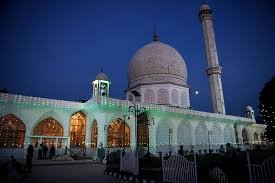The recent Hazratbal shrine controversy reveals how systems operate without understanding the minds they claim to serve. Furthermore, this incident demonstrates the dangerous gap between governance and genuine spiritual sensitivity. Additionally, it shows why we must question every institutional decision affecting our sacred spaces.

A marble plaque bearing the Ashoka emblem at Kashmir’s holiest shrine triggered massive protests and political upheaval. Moreover, the controversy exposes deeper patterns of institutional arrogance disguised as administrative efficiency. Therefore, this isn’t merely about religious symbols but about who controls our spiritual narrative.
The System’s Religious Insensitivity Exposed
The Jammu and Kashmir Waqf Board, under BJP leader Darakhshan Andrabi’s leadership, installed a plaque featuring the national emblem at Hazratbal shrine after renovation work. However, this decision ignored fundamental Islamic principles that strictly prohibit figurative representations in sacred spaces. Consequently, worshippers reacted emotionally during Eid-e-Milad prayers, vandalizing the controversial emblem.
Chief Minister Omar Abdullah questioned this institutional overreach directly. He stated that government emblems belong in offices, not religious places. Moreover, he emphasized that mosques, shrines, temples, and gurdwaras are spiritual institutions, not government facilities. Therefore, using state symbols in sacred spaces violates both religious sensitivity and administrative appropriateness.
“The first question is whether the emblem should have been etched on the stone. I have never seen the emblem being used in any religious institution or function.”
Mehbooba Mufti took a stronger stance, calling the installation an act of blasphemy. She demanded legal action under sections dealing with hurting religious sentiments. Additionally, she urged dissolution of the current Waqf Board for failing to understand the communities it serves.
Systems vs Souls: The Fundamental Disconnect
This controversy perfectly illustrates how systems prioritize symbolism over substance. The installation wasn’t about genuine development or spiritual enhancement. Instead, it represented institutional ego-projection onto sacred spaces that belonged to the community’s collective consciousness.
Notice how the system operates: bureaucrats make decisions affecting millions without consulting the actual stakeholders. Furthermore, when communities react to protect their sacred traditions, the system criminalizes their emotional responses rather than examining its own insensitivity.
The Waqf Board’s response proves this pattern. Rather than acknowledging the mistake, Andrabi demanded Public Safety Act charges against protestors. This reaction reveals how institutional power protects itself while labeling justified community anger as “terrorism.”
Key Insights:
First, systems lack spiritual intelligence. Administrative efficiency cannot substitute for cultural wisdom or religious understanding. However, institutions often impose mechanical solutions on organic community needs. Therefore, we must question whether bureaucrats possess the sensitivity required for managing sacred spaces.
Second, institutional ego supersedes community welfare. The plaque served no spiritual purpose but satisfied administrative credit-seeking. Moreover, it demonstrated how systems use religious spaces for political branding. Consequently, sacred areas become venues for institutional self-promotion rather than genuine devotion.
Third, systems criminalize justified resistance. When communities defend their spiritual boundaries, institutions label them as troublemakers or terrorists. Furthermore, this pattern repeats across different contexts where authentic voices challenge system overreach. Therefore, we must recognize this manipulation technique.
The Political Theater Unveiled
Multiple political parties exploited this controversy for electoral positioning. The National Conference demanded Andrabi’s dismissal while calling for Assembly investigations. Meanwhile, the BJP defended the emblem installation as patriotic duty while condemning vandalism as terrorism.
However, the deeper game being played reveals itself clearly. Both sides use religious sensitivity as political ammunition rather than genuinely protecting community interests. Furthermore, the controversy conveniently emerged during election season, suggesting calculated timing for maximum political impact.
The Mutahida Majlis Ulema’s statement carried more authenticity than political party responses. They emphasized that Islam explicitly prohibits plaques, emblems, or symbols in mosques and shrines. Moreover, they noted that previous renovations never included such installations, respecting traditional Islamic principles.
Breaking Free from System Control
This incident provides several lessons for conscious individuals seeking mental liberation from institutional manipulation:
Recognize Pattern Recognition. Systems repeatedly ignore community wisdom in favor of administrative convenience. Furthermore, they blame communities for defending their legitimate interests. Therefore, develop the ability to spot these recurring patterns across different contexts.
Understand Emotional Manipulation. Notice how the system labels justified anger as “terrorism” or “extremism.” This technique discourages future resistance by criminalizing natural emotional responses to institutional overreach. Moreover, it shifts blame from system mistakes to community reactions.
Question Authority Claims. Just because someone holds an official position doesn’t mean they understand the communities they serve. Additionally, institutional titles often mask ignorance of local customs, traditions, and sensitivities. Therefore, evaluate decisions based on wisdom rather than authority.
Defend Sacred Boundaries. Communities have the right to protect their spiritual spaces from inappropriate intrusions. Furthermore, this protection doesn’t require permission from external authorities who lack understanding of local traditions. Moreover, maintaining sacred boundaries preserves cultural integrity against system homogenization.
Conscious Resistance Strategies
The community must resist institutional overreach while avoiding the system’s traps. The Hazratbal protestors demonstrated justified anger but played into system narratives by resorting to vandalism. However, smarter resistance strategies exist.
Strategic Documentation: Record every instance of institutional insensitivity for future reference and pattern recognition. This approach builds evidence of systematic problems rather than isolated incidents.
Community Education: Teach others to recognize manipulation techniques before crises occur. Furthermore, educated communities respond more strategically to institutional provocations.
Legal Knowledge: Understand laws protecting religious rights and cultural practices. Moreover, use this knowledge to challenge inappropriate system decisions through proper channels before emotions escalate.
Coalition Building: Connect with others who recognize similar patterns across different contexts. Additionally, broader awareness makes it harder for systems to isolate and target individual communities.
Beyond Politics: Spiritual Sovereignty
The Hazratbal controversy ultimately concerns spiritual sovereignty versus institutional control. Communities must maintain authority over their sacred spaces while systems seek to extend administrative dominance into every aspect of human experience.
This battle extends beyond religious issues into fundamental questions about who controls our minds, hearts, and souls. Furthermore, systems that cannot respect sacred boundaries will eventually violate all human boundaries.
“In a world full of noise, systems, and distractions, clarity, control, and conscious living become our only refuge.”
The system’s response to this controversy reveals its true character. Instead of acknowledging mistakes and learning from community wisdom, it doubled down on institutional arrogance while criminalizing justified resistance.
Conscious individuals must learn from this pattern. Systems will continue creating such controversies because they cannot understand the human hearts they claim to serve. Therefore, our response must combine strategic thinking with unwavering defense of what matters most.
The Path Forward: Awakening Community Consciousness
Twenty-six people were detained following the vandalism incident, demonstrating how quickly systems move to punish community reactions while ignoring the institutional failures that triggered them. Furthermore, FIRs were registered against protestors, but no action was taken against those who made the insensitive decision initially.
This selective accountability reveals the system’s true priorities. Protecting institutional image matters more than addressing genuine grievances or preventing similar incidents in the future. Moreover, communities learn that emotional responses will be criminalized regardless of their legitimacy.
However, conscious communities can respond differently. Instead of reactive anger, they can build proactive strategies for protecting their interests. Additionally, they can educate members about system manipulation techniques before crises occur.
The Hazratbal incident teaches us that spiritual spaces require conscious guardianship from those who understand their significance. Furthermore, institutional titles cannot substitute for genuine cultural sensitivity and religious understanding.
Remember: this isn’t about Hindu-Muslim politics or regional grievances. This represents the eternal struggle between conscious living and system control. Choose consciousness over compliance, wisdom over institutional authority, and spiritual sovereignty over administrative convenience.
The Hazratbal shrine will heal from this controversy. However, the lessons about system behavior and community resistance must inform our future strategies. Communities that understand these patterns can protect their sacred spaces while building broader movements for genuine autonomy and respect.





